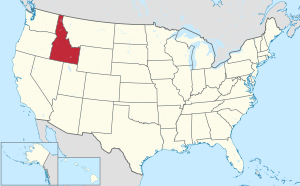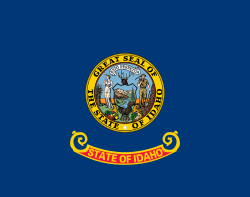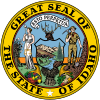
Back Idaho Afrikaans አይዳሆ Amharic Idaho AN Idaho ANG أيداهو Arabic ܐܝܕܐܗܘ ARC آيداهو ARY ايداهو ARZ Idaho AST Idaho suyu Aymara
Idaho | |
|---|---|
| Nickname(s): The Gem State (official), The Potato State | |
| Motto: | |
| Anthem: "Here We Have Idaho" | |
 Location of Idaho within the United States | |
| Country | United States |
| Before statehood | Oregon Territory, Washington Territory, Idaho Territory |
| Admitted to the Union | July 3, 1890 (43rd) |
| Capital (and largest city) | Boise |
| Largest county or equivalent | Ada |
| Largest metro and urban areas | Boise |
| Government | |
| • Governor | Brad Little (R) |
| • Lieutenant Governor | Scott Bedke (R) |
| Legislature | Legislature |
| • Upper house | Senate |
| • Lower house | House of Representatives |
| Judiciary | Idaho Supreme Court |
| U.S. senators | Mike Crapo (R) Jim Risch (R) |
| U.S. House delegation | 1. Russ Fulcher (R) 2. Mike Simpson (R) (list) |
| Area | |
• Total | 83,570[2] sq mi (216,444 km2) |
| • Land | 82,644 sq mi (214,046 km2) |
| • Water | 927 sq mi (2,399 km2) 1.11% |
| • Rank | 11th |
| Dimensions | |
| • Length | 479 mi (771 km) |
| • Width | 305 mi (491 km) |
| Elevation | 5,000 ft (1,520 m) |
| Highest elevation | 12,662 ft (3,859 m) |
| Lowest elevation | 713 ft (217 m) |
| Population (2024) | |
• Total | |
| • Rank | 38th |
| • Density | 23.63/sq mi (8.33/km2) |
| • Rank | 44th |
| • Median household income | $74,900 (2023)[6] |
| • Income rank | 31st |
| Demonym | Idahoan |
| Language | |
| • Official language | English[7] |
| Time zones | |
| primary | UTC−07:00 (Mountain) |
| • Summer (DST) | UTC−06:00 (MDT) |
| Idaho Panhandle | UTC−08:00 (Pacific) |
| • Summer (DST) | UTC−07:00 (PDT) |
| USPS abbreviation | ID |
| ISO 3166 code | US-ID |
| Latitude | 42° N to 49° N |
| Longitude | 111°03′ W to 117°15′ W |
| Website | idaho |
| List of state symbols | |
|---|---|
 | |
 | |
| Living insignia | |
| Amphibian | Tiger salamander (Ambystoma tigrinum) |
| Bird |
|
| Fish | Cutthroat trout (Oncorhynchus clarkii) |
| Flower | Syringa (Philadelphus lewisii) |
| Horse breed | Appaloosa |
| Insect | Monarch butterfly (Danaus plexippus) |
| Tree | Western white pine (Pinus monticola) |
| Inanimate insignia | |
| Dance | Square dance |
| Food |
|
| Fossil | Hagerman horse (Equus simplicidens) |
| Gemstone | Star garnet |
| Soil | Threebear |
| State route marker | |
 | |
| Lists of United States state symbols | |
Idaho (/ˈaɪdəhoʊ/ ⓘ EYE-də-hoh) is a landlocked state in the Pacific Northwest and Mountain West subregions of the Western United States. It borders Montana and Wyoming to the east, Nevada and Utah to the south, and Washington and Oregon to the west; the state shares a small portion of the Canada–United States border to the north with the Canadian province of British Columbia. Idaho's state capital and largest city is Boise. With an area of 83,569 square miles (216,440 km2), Idaho is the 14th-largest state by land area. The state has a population of approximately two million people; it ranks as the 13th-least populous and the seventh-least densely populated of the 50 U.S. states.
For thousands of years, and prior to European colonization, Idaho had been inhabited by native peoples. In the early 19th century, Idaho was considered part of the Oregon Country, an area which was disputed between the U.S. and the British Empire. Idaho officially became a U.S. territory with the signing of the Oregon Treaty of 1846, but a separate Idaho Territory was not organized until 1863, instead being included for periods in Oregon Territory and Washington Territory. The state was eventually admitted to the Union on July 3, 1890, becoming the 43rd state.
Forming part of the Pacific Northwest (and the associated Cascadia bioregion), Idaho is divided into several distinct geographic and climatic regions. The state's north, the relatively isolated Idaho Panhandle, is closely linked with Eastern Washington, with which it shares the Pacific Time Zone—the rest of the state uses the Mountain Time Zone. The state's south includes the Snake River Plain (which has most of the population and agricultural land), and the southeast incorporates part of the Great Basin. Idaho is quite mountainous and contains several stretches of the Rocky Mountains. The United States Forest Service holds about 38% of Idaho's land, the highest proportion of any state.[8]
Industries significant for the state economy include manufacturing, agriculture, mining, forestry, and tourism. Several science and technology firms are either headquartered in Idaho or have factories there, and the state also contains the Idaho National Laboratory, which is the country's largest Department of Energy facility. Idaho's agricultural sector supplies many products, but the state is best known for its potato crop, which comprises around one-third of the nationwide yield. The official state nickname is the "Gem State".[9]
- ^ "Facts & Symbols". The Official Website of the State of Idaho. Access Idaho. Retrieved May 8, 2023.
- ^ [1] United States Census Bureau—Population, Housing Units, Area, and Density: 2010
- ^ "Beauty Reset". NGS Data Sheet. National Geodetic Survey, National Oceanic and Atmospheric Administration, United States Department of Commerce. Retrieved October 20, 2011.
- ^ a b "Elevations and Distances in the United States". United States Geological Survey. 2001. Archived from the original on October 15, 2011. Retrieved October 21, 2011.
- ^ "United States Census Quick Facts Idaho". Retrieved January 9, 2025.
- ^ "Household Income in States and Metropolitan Areas: 2023" (PDF). Retrieved January 12, 2025.
- ^ "Idaho Statutes (73-121)". State of Idaho. 2017. Archived from the original on December 8, 2017. Retrieved December 7, 2017.
- ^ "Western States Data Public Land Acreage", wildlandfire.com. Archived on July 27, 2011. Retrieved January 3, 2020.
- ^ Wells, Merle W. "Origins of the Name "Idaho" and How Idaho Became a Territory in 1863" (PDF). Archived (PDF) from the original on April 6, 2019. Retrieved January 16, 2019.
Cite error: There are <ref group=lower-alpha> tags or {{efn}} templates on this page, but the references will not show without a {{reflist|group=lower-alpha}} template or {{notelist}} template (see the help page).

